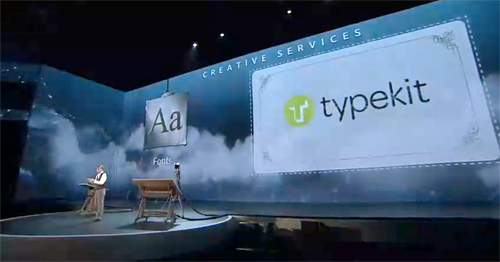Welcome, Typekit!
By now, the news has reached the farthest corners of the Web: Adobe has acquired Typekit. Adobe made the announcement at Adobe MAX 2011 on Monday, Typekit spread the news on its blog, and tweets and other assorted commentary followed. After taking some time to come down from the excitement of the announcement and the reaction to it, I want to add my own thoughts and some general observations, from my vantage point here in the Adobe Type group.
To first state the obvious: the Adobe Type team is very pleased and excited to have Typekit at Adobe. Our job here has always been (for over 25 years!) to ensure that Adobe customers have powerful and satisfying typographic tools at their disposal. Whether it’s designing typefaces, creating type-related technology, or providing guidance to other Adobe teams, we want designers and content creators to be able to use type and typography effectively. Typekit comes to Adobe having helped make rich typography a regular part of the Web — and having made their customers happier and more successful. With their talent and enthusiasm, I expect them to help transform how our customers deal with type throughout their creative workflow.
Still, we know some of you are concerned. Although change for both Typekit and Adobe is inevitable, I’m confident that our customers will be pleased with where we’re headed.
First, I’ve heard anxiety about the future of Typekit’s font library and foundry partners. Adobe has its own type library, but we know typographic choice is very important to our customers. In fact, designers want access to as many fonts as possible, so we will actively seek new foundry partnerships to give our customers as much choice as we can. We are pleased to welcome Typekit’s current foundry partners to the fold, and many of them have already told us they are looking forward to the opportunity to expand their reach into Adobe’s applications and services. In other words, if you are an anxious Typekit customer, you can look forward to more choice, not less.
Another prevalent concern is that this acquisition portends “the end of affordable web fonts.” Not so! Typekit remains the same service it has always been, with the same fonts and the same features and prices. We know that Typekit’s customers love their pricing. The other side of that relationship is font designers and foundries, who deserve a fair price for their product. It’s a delicate balance to keep both customers and foundries happy, but by now it should be abundantly clear — from Adobe’s own statements and Typekit’s blog — that we all understand that what Typekit has created is working very well.

Adobe CTO Kevin Lynch announces the Typekit acquisition at Adobe MAX on October 3, 2011.
This does not mean that Typekit won’t evolve in the right ways. On its own, Typekit has been developing new features and other improvements. (Those who watched Jeff Veen’s demonstration during the opening keynote at Adobe MAX on Monday got a glimpse of new interface improvements, for example.) Those enhancements will still roll out, and as you’ve heard, we see a great opportunity to make Typekit an integral part of the Adobe Creative Cloud and everything else Adobe does. With this acquisition, there is the potential to evolve Typekit in ways that simply wouldn’t have been possible otherwise.
So now the hard work begins. We know Typekit’s customers and foundry partners have trusted them so far, and that it’s now up to us to show everyone how much better it can get — but we are excited by the possibilities, and can’t wait to start working with the Typekit team and everyone else at Adobe to take type and rich web content to the next level.
2 Responses
Comments are closed.
if adobe were truly interested in “customer choice” it would also provide web fonts from its foundry for *purchase* rather than subscription. jeez.
It doesn’t make sense to sell people licenses to something that won’t meet their needs. The state of browsers today is such that five different font formats are required, with appropriate security to protect the fonts. This isn’t something most web developers can handle on their own, so we’re working with the best services (Typekit and WebINK) available.